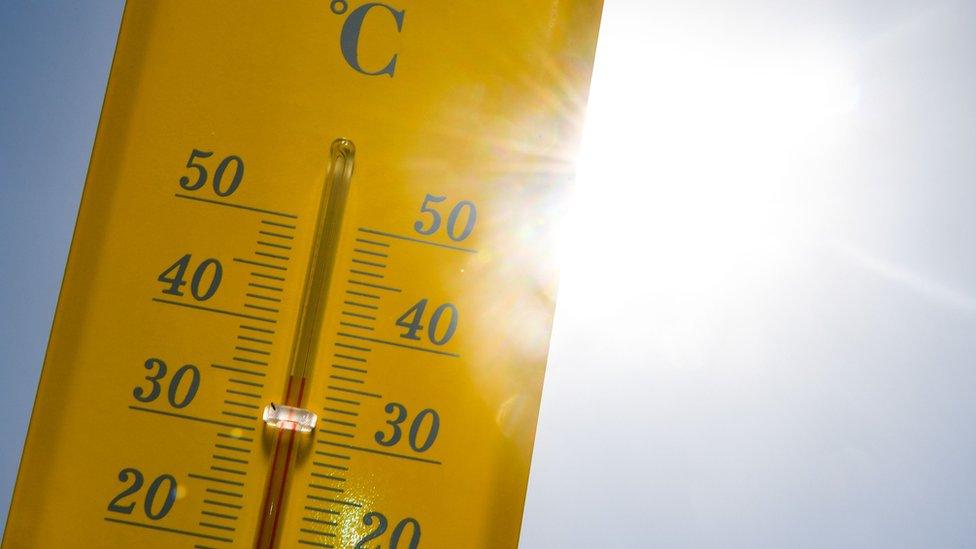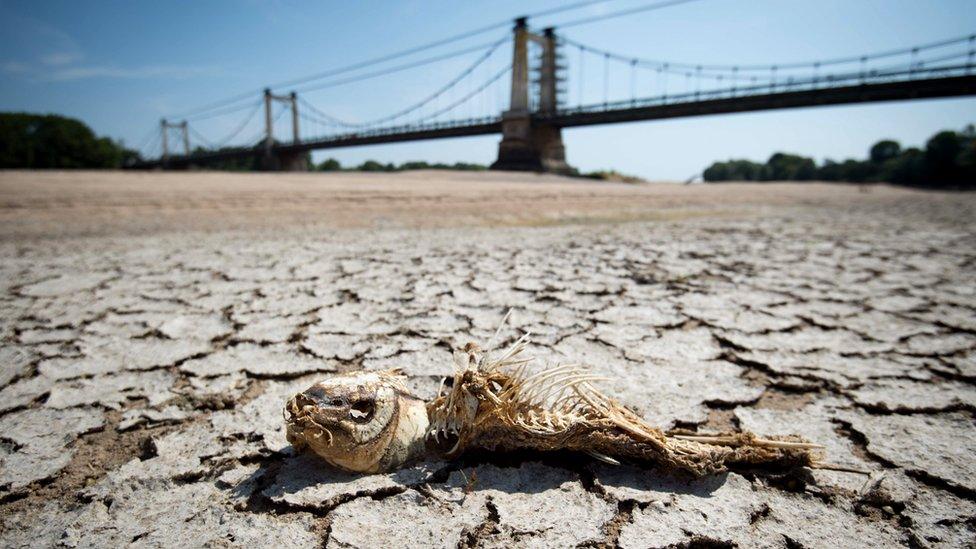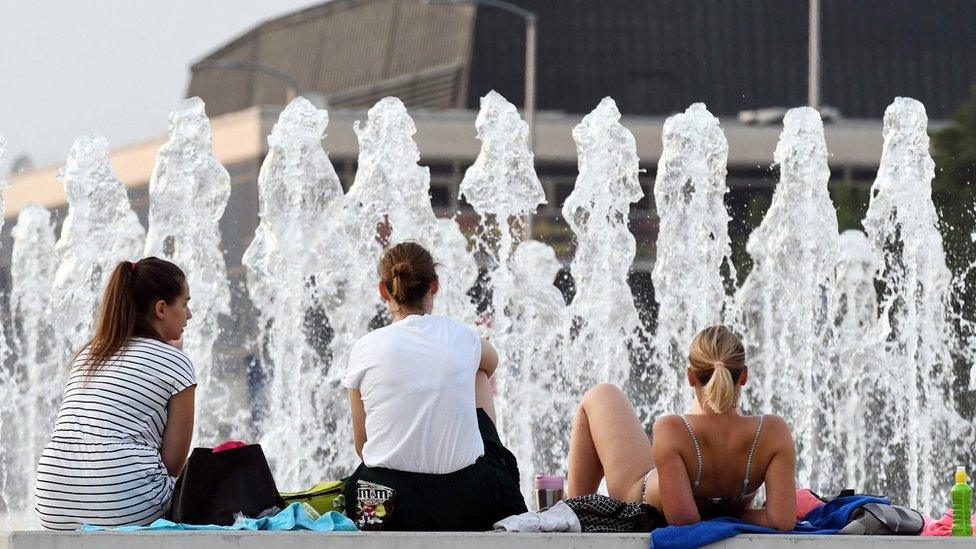Europe heatwave: Why are temperatures on the continent soaring?
- Published

Countries across Europe are sweltering under the heat
Parts of Europe are scorching as a second heatwave in as many months brings record-breaking high temperatures, prompting governments to issue health alerts urging people to keep cool.
This month's heat has, much like June's soaring temperatures, caused forest fires, buckled train tracks and led to warnings over air quality and water shortages.
A red alert has been issued in France - with temperatures hitting 40.6C in Paris - while Belgian, German and Dutch temperature records could be broken for the second time in two days.
Last month, France set an all-time high-temperature record of 46C, and new highs were set in the Czech Republic, Slovakia, Austria, Andorra, Luxembourg, Poland and Germany - making it the hottest June on record.
As the mercury continues to rise, experts tell the BBC why we should expect heatwaves to become more frequent.
Why is this happening now?
Heatwaves occur across northern Europe when high atmospheric pressure draws up hot air from northern Africa, Portugal and Spain, raising temperatures and increasing humidity.


Timothy Hewson, who leads a forecasting team at the European Centre for Medium-Range Weather Forecasts (ECMWF), said clear skies added to the strength of the sunshine, further increasing temperatures. He said dry soil conditions also contributed, as this resulted in less evaporation, which ordinarily cools the ground.
Heatwaves are not uncommon, but according to weather experts they are being amplified by a rise in global temperatures and are likely to become more frequent - one of the more predictable impacts of our warming climate.
A climate specialist at the UK's Meteorological Office, Grahame Madge, told the BBC that, while weather variations occurred naturally, the world was about one degree warmer than pre-industrial levels and, as a result, extreme weather was becoming more likely.
"Now when we get a heatwave, it is likely to be a degree or so more," he said. "They are still extreme events, but they are also becoming more frequent."
A coati eating iced fruit in a Rome zoo
The highest recorded temperature in Europe - 48C (118.4F) - was measured in Athens in July 1977, but on average the 20 warmest years since records began have all been within the past 22 years. The years 2015-2018 make up the top four, according to the World Meteorological Organization (WMO).
Is the warming caused by human activity?
A scientific study into last year's Europe-wide heatwave by the World Weather Attribution group concluded that high temperatures in the region were made more likely by human activities that contributed to climate change, external.
If the current trend were to continue, heatwaves across Europe could occur as often as every other year by the 2040s, with the possibility that overall average temperatures might have risen by 3-5C by 2100, the report said.
What exactly is a heatwave?
There is no universally accepted definition of a heatwave, due to variations in climate conditions in different world regions. Typically though, they are defined by an unseasonably hot period - usually five degrees or more above the average daily maximum - that lasts at least three days.
Other factors considered by analysts, Mr Hewson said, included night-time temperatures, humidity and wind speed. Both humidity and low wind speeds can enhance a heatwave. The effects can be particularly extreme in large cities due to increased human activity and a mass of buildings, concrete and roads.

The skeleton of a fish lies on a dry part of the bed of the River Loire in western France
"In terms of the time of year and spatial pattern of warmth, the ongoing event in Europe is quite similar to the 2015 European heatwave," Mr Hewson said.
The most severely affected areas during that heatwave were southern and central Europe, but there were also temperature records set in Germany and Switzerland.
Why are heatwaves dangerous?
Higher temperatures can affect anyone, but dehydration, heat exhaustion and heatstroke can have deadly consequences for people who suffer from cardiac, kidney and respiratory diseases, as well as the elderly and infants.
"Heatwaves can be dangerous because they reduce the capacity of the human body to regulate its own temperature, to keep it at safe levels," Mr Hewson said.
Vulnerable people may suffer particularly if overnight temperatures do not drop below 25C, said Mr Madge, the Met Office climate specialist.
Health professionals advise that anyone experiencing headaches, dizziness, loss of appetite, nausea, excessive sweating, cramps, fast breathing or intense thirst should try to find a way to cool off.

Tourists freshening up at a fountain near the Pantheon monument in Rome in June
If a person's body temperature rises above 40C (104F), heat stroke can set in, requiring urgent medical help. Danger signs include sweat stopping and breathing difficulties. Heat stroke can lead to loss of consciousness and serious complications, including permanent damage to vital organs or even death.
After the 2003 heatwave, about 70,000 additional deaths were recorded, external in Europe compared with previous years, according to a scientific and medical study.
Multiple deaths have been reported in the latest heatwave. Two people died in Spain from suspected heatstroke, while UK police warned of the dangers of cooling off in rivers and lakes after a 12-year-old girl drowned.
What happens in hotter countries?
Nations with hotter climates, such as Australia and countries in North Africa and across the Middle East - where summer temperatures can often reach 50C - can still struggle with extreme weather.
"Their infrastructure might be able to cope with higher temperatures in general, but with anything away from the norm, everywhere struggles," Mr Madge said.
When asked how they keep cool in extreme heat, BBC colleagues living in Nigeria, Tanzania, Yemen and Brazil had the following advice for countries with more variable climates:
Clothing: Wear something loose and light, both in weight and in colour
Washing: Shower frequently in cool water
Stay hydrated: Consume lots of water
Towels: Carry a small flannel to soak in water and daub your face
Bedding: Sleep in thin cotton sheets
Ventilation: Open windows (except in the midday sun), close shutters and use fans
BBC colleagues from hot countries give their tips for staying cool
- Published25 July 2019

- Published25 June 2020
